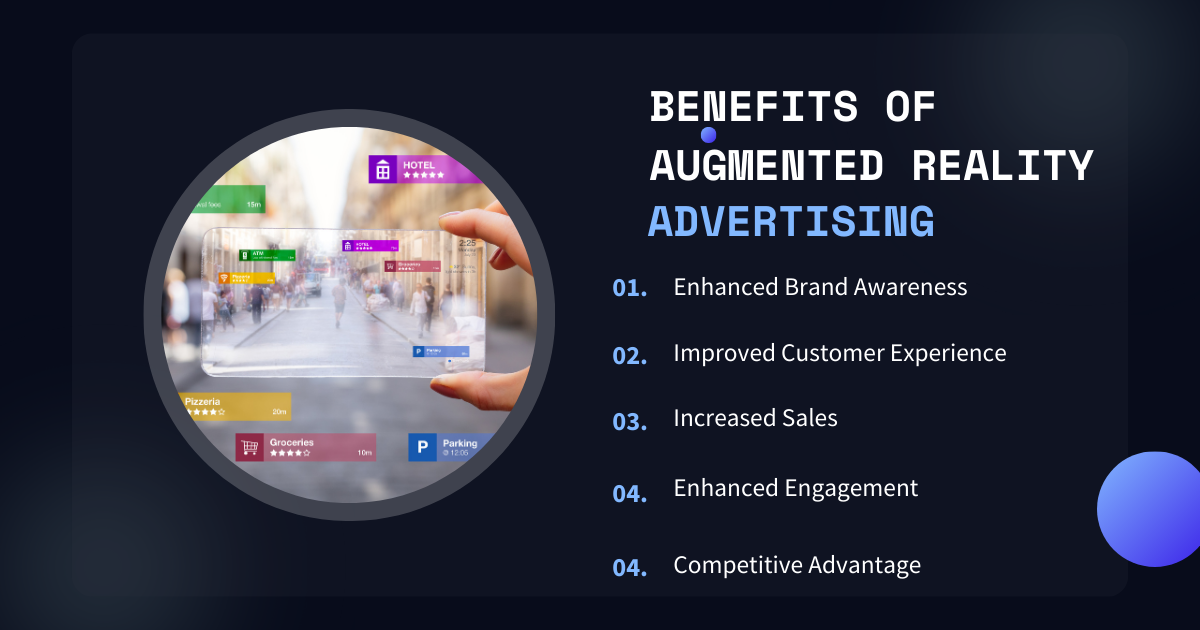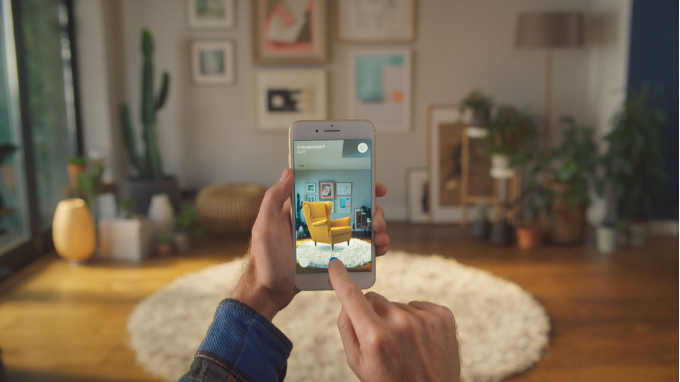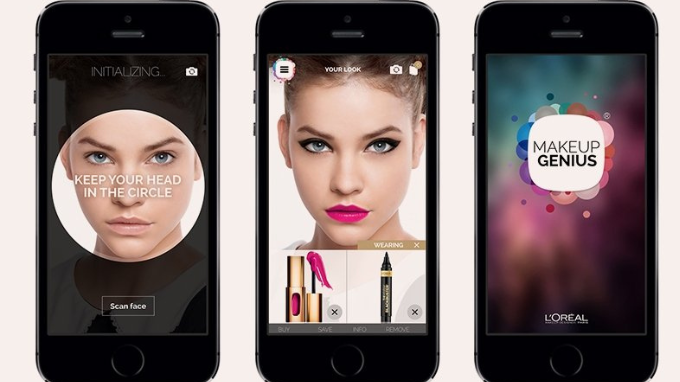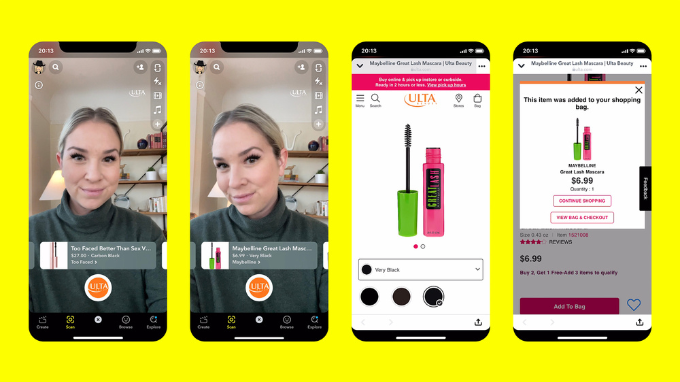By leveraging AR, brands can transform their marketing campaigns into interactive experiences that captivate and immerse their target audience. In this guide, we’ll delve into the various benefits of augmented reality advertising, provide actionable tips for implementing it effectively, and share real-world case studies of brands that have successfully used AR to boost brand engagement.
So, if you’re ready to take your advertising to the next level and create unforgettable experiences for your audience, read on.
What is Augmented Reality and Advertising?
AR advertising seamlessly blends digital elements into the real world, allowing users to interact with virtual content overlaid on their surroundings. This technology has the power to transform advertising from a passive experience into an active, interactive one, breaking down the barriers between brands and their consumers.Benefits of augmented reality in advertising
Here are many benefits to using AR advertising, including:

- Increased engagement: AR experiences are more engaging than traditional ads because they allow consumers to interact with the brand in a more meaningful way. This makes them more likely to remember the ad and share it with others.
- create memorable experiences. By allowing consumers to interact with virtual elements in their physical environment, AR creates a sense of wonder and excitement. This emotional connection can leave a lasting impression on consumers, making them more likely to share their experiences with others and become brand advocates. Additionally, AR can provide brands with valuable data and insights about consumer behavior, allowing them to refine and optimize their advertising campaigns.
- Improved brand awareness: AR experiences can help to create a stronger brand identity and increase brand awareness. This can be achieved by using AR to showcase a brand’s products or services in a new and innovative way.
- Enhanced customer experience: AR can be used to provide customers with a more personalized and immersive experience. This can be done by allowing them to try on products virtually, explore products in their own homes, or get a virtual tour of a store.
- Reduced product returns: AR can help to reduce product returns by allowing customers to see how a product looks and fits before they buy it. This can be particularly helpful for products that are difficult to visualize, such as furniture or clothing.
- Improved sales: AR can increase sales by making it easier for customers to make informed decisions about their purchases. This can be done by providing customers with additional information about products, such as product specifications and customer reviews.
Augmented reality advertising examples and success stories

To truly understand the power of augmented reality advertising, let’s take a look at some real-world examples and success stories. One notable example is the collaboration between IKEA and Apple. Through the IKEA Place app, users can preview how furniture would look and fit in their own homes using AR technology.
This not only provides a fun and interactive shopping experience but also helps customers make more informed purchasing decisions.
The app has been widely praised for its usability and has significantly increased IKEA’s online sales.
Another success story comes from the beauty industry, where brands like L’Oreal and Sephora have embraced AR to enhance the customer experience. L’Oreal’s Makeup Genius – From Day To Night

Makeup Genius app allows users to try on virtual makeup looks in real-time, helping them find the perfect products without having to physically try them on.
Sephora’s Virtual Artist app takes it a step further, allowing users to virtually try on different shades of lipstick and see how they would look on their faces.
These apps have not only increased customer engagement but also boosted sales by providing a convenient and personalized shopping experience.
How do augmented reality and advertising work?
At its core, augmented reality advertising works by overlaying virtual elements onto the real world. This is typically achieved through the use of a mobile device’s camera and screen.
When a user activates an AR experience, the camera captures the user’s physical environment, and the AR software identifies key features and markers to anchor the virtual elements.
The virtual elements are then superimposed onto the live camera feed, creating a seamless blend of the virtual and real world.
To create an augmented reality advertising campaign, brands need to develop a compelling concept that aligns with their brand identity and marketing objectives. This concept can range from interactive games and experiences to virtual try-on features and product demonstrations.
Augmented reality advertising: Where the real world meets the limitless possibilities of imagination.
Once the concept is defined, brands can work with AR developers and designers to bring the experience to life. This involves creating 3D models, animations, and interactive elements that will be integrated into the AR experience.
To deliver the AR experience to consumers, brands can leverage various platforms and tools. These include dedicated AR apps, social media platforms with AR capabilities, and even web-based AR experiences.
The choice of platform will depend on the target audience, budget, and desired reach. Once the AR experience is live, brands can promote it through various channels, including:
- social media,
- email marketing,
- influencer partnerships.
Creating an augmented reality and advertising campaign
To create a successful augmented reality advertising campaign, brands need to follow a strategic approach.
The first step is to define clear objectives and target audiences.
- What do you want to achieve with your AR campaign?
- Who is your target audience?
- Understanding these key elements will help shape the concept and design of your AR experience.
Next, brands should focus on creating a seamless and intuitive user experience. AR can be a complex technology, so it’s important to ensure that users can easily navigate and interact with the virtual elements. Clear instructions, intuitive controls, and responsive design are essential for a positive user experience.
When it comes to content, brands should strive to create engaging and shareable experiences.
This can include:
- gamifying the AR experience,
- offering exclusive discounts or rewards,
- or even incorporating user-generated content.
The key is to make the experience fun, interactive, and memorable, so users are more likely to share it with their friends and followers.
Lastly, brands should not forget about measurement and optimization.
By tracking key metrics such as
- engagement,
- conversion rates,
- and social sharing,
brands can gain valuable insights into the effectiveness of their AR campaign. This data can then be used to refine and optimize future campaigns, ensuring continuous improvement and better results.
Augmented reality and advertising platforms and tools
When it comes to augmented reality advertising, there are several platforms and tools available to brands.

One popular platform is Snapchat, which offers a range of AR features, including lenses and filters. Brands can leverage these features to create interactive and engaging experiences that reach millions of Snapchat users. Snapchat also provides robust analytics and targeting options, allowing brands to measure and optimize their AR campaigns.
Another platform worth considering is Facebook. With its Spark AR Studio, brands can create AR effects and filters for both Facebook and Instagram. These effects can be used to enhance brand awareness, promote products, and even drive sales. Facebook’s extensive user base and targeting capabilities make it a powerful platform for reaching and engaging with a wide audience.

For brands looking for a more customized and branded AR experience, there are dedicated AR app development platforms available. These platforms, such as Unity and ARCore, provide the tools and resources needed to create highly interactive and immersive AR experiences. While these platforms require more technical expertise and investment, they offer greater flexibility and control over the AR experience.
Augmented reality and advertising metrics and measurement
To measure the success of an augmented reality advertising campaign, brands should track key metrics and performance indicators. These metrics can include:
– Engagement: How many users interacted with the AR experience? This can be measured by the number of app downloads, visits to AR-enabled web pages, or views of AR effects on social media platforms.
– Conversion rates: Did the AR experience drive desired actions, such as product purchases or sign-ups? By tracking conversion rates, brands can assess the effectiveness of their AR campaigns in driving tangible business outcomes.
– Social media sharing: How many users shared the AR experience with their friends and followers? Social sharing is a valuable indicator of user satisfaction and the potential reach and impact of the campaign.
– Time spent: How much time did users spend engaging with the AR experience? This metric can help brands understand the level of user interest and engagement with the campaign.
By regularly monitoring and analyzing these metrics, brands can gain insights into the effectiveness of their augmented reality advertising campaigns. This data can then be used to optimize future campaigns and improve overall performance.
Augmented reality and advertising best practices
To ensure the success of an augmented reality advertising campaign, brands should follow these best practices:
– Keep it simple: AR experiences should be intuitive and easy to use. Avoid overwhelming users with complex controls or too much information. Focus on creating a seamless and enjoyable user experience.
– Personalize the experience: Tailor the AR experience to the individual user whenever possible. This can include personalizing product recommendations, offering exclusive discounts, or incorporating user-generated content.
– Test and optimize: Before launching an AR campaign, thoroughly test the experience to ensure it works seamlessly across different devices and platforms. Regularly analyze performance data and make adjustments to improve user engagement and conversion rates.
– Promote and amplify: Don’t rely solely on organic reach. Actively promote your AR experience through various channels, including social media, email marketing, and influencer partnerships. Consider running targeted ads to reach a wider audience.
– Iterate and innovate: AR technology is constantly evolving, so don’t be afraid to experiment with new features and techniques. Stay up to date with the latest trends and innovations in augmented reality advertising and be willing to adapt and iterate your campaigns.
Challenges and limitations of augmented reality advertising
Technical Limitations
AR technology is still in its early stages of development, and several technical limitations can impact the user experience.
These include:
- Latency: The time delay between a user’s action and the AR content response can be noticeable and disruptive, especially in applications that require precise movements.
- Tracking Accuracy: AR systems rely on accurate object and environment tracking to overlay virtual elements onto the real world. However, challenges like lighting conditions, occlusion (blocking by other objects), and textureless surfaces can affect tracking accuracy.
- Low-Quality Graphics: Poorly rendered graphics can detract from the immersiveness of the AR experience and make it less engaging.
- Limited Device Compatibility: AR experiences are currently primarily accessible through smartphones and tablets, and there is still a significant portion of the population without compatible devices.
Accessibility and User Adoption
Despite the increasing penetration of smartphones, not all users have access to devices that can support AR experiences. Additionally, some consumers may be hesitant to engage with AR due to privacy concerns, data usage limitations, or simply a lack of familiarity with the technology.
Cost Considerations
Creating engaging AR experiences can be expensive, as it requires specialized skills and tools. Developing high-quality 3D models, designing interactive elements, and ensuring compatibility across different platforms can add up quickly.
Limited Content Availability
The current availability of AR content is still limited, particularly for specific industries or niche products. This can make it challenging for brands to find relevant and engaging AR experiences for their target audience.
Overcoming Challenges and Limitations
Despite these challenges, AR advertising holds immense promise for brands. By carefully considering the limitations and taking steps to address them, brands can effectively harness the power of AR to create truly impactful and memorable experiences for their consumers.
Here are some strategies to overcome AR advertising challenges:
- Prioritize Simplicity and Relevance: Focus on creating simple and intuitive AR experiences that are relevant to the brand and target audience.
- Ensure Device Compatibility: Target devices with widespread adoption and provide clear instructions for users without compatible devices.
- Address Privacy Concerns: Emphasize responsible data collection practices and provide clear opt-in options for data sharing.
- Invest in Quality Content: Create high-quality 3D models, interactive elements, and user interface designs to enhance the user experience.
- Leverage AR Platforms: Utilize established AR platforms to reach a wider audience and simplify content development.
Educate the Audience: Provide clear tutorials, user guides, and support resources to help users understand and interact with AR experiences.
The Future of AR Advertising
AR advertising is still in its early stages of development, but its potential is vast. As the technology matures and becomes more accessible, we can expect to see even more innovative and engaging AR advertising campaigns.
Imagine seeing billboards that react to your presence, interactive product demos that guide you through the features of a new gadget, or AR-powered museum tours that bring history to life.
Related: Virtual Reality in Advertising | 100% Customer Engagement
The future of AR advertising is bright, promising to transform the way brands connect with consumers and create memorable experiences that leave a lasting impression. As AR technology continues to evolve, we can expect to see even more innovative and immersive AR advertising campaigns that redefine the way we interact with brands in the digital world.
Key Takeaways:
- AR advertising offers a unique and engaging way to connect with consumers, breaking through the clutter of traditional advertising.
- AR technology enhances product visualization, providing consumers with a more realistic and interactive experience.
- AR enables interactive experiences that go beyond traditional advertising, fostering deeper engagement with consumers.
- AR-powered personalization allows brands to deliver tailored experiences that resonate with individual consumers.
- The future of AR advertising holds immense promise, with the potential to revolutionize the way brands interact with consumers.
